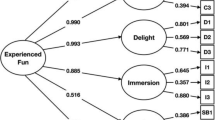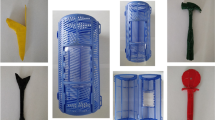Abstract
The paper presents the Fun Toolkit (v3), a survey instrument that has been devised to assist researchers and developers to gather opinions about technology from children. In presenting the toolkit, the paper provides a reflective look at several studies where the toolkit has been validated and considers how the Fun Toolkit should be used as well as discussing how, and in what way, the instruments contained within it should be employed. This consideration of use is one of the novel contributions of the paper. The second major contribution is the discussion based around software appeal; in which the fit between the Fun Toolkit and usability and engagement is explored. The paper concludes that the Fun Toolkit is useful, that it can be used with some confidence to gather opinions from children and that it has the potential for use for other user experiences.




Similar content being viewed by others
Explore related subjects
Discover the latest articles and news from researchers in related subjects, suggested using machine learning.References
Airey S, Plowman L, Connolly D, Luckin R (2002) Rating children’s enjoyment of toys, games and media. In: 3rd world congress of international toy research on toys, Games and Media, London
Barendregt W, Bekker MM, Bouwhuis DG, Baauw E (2006) Identifying usability and fun problems in a computer game during first use and after some practice. Int J Human Comput Stud 64:830–846
Bark I, Folstad A, Gulliksen J (2005) Use and usefulness of HCI methods: results from an exploratory study among nordic HCI practitioners, HCI 2005. Springer, Edinburgh
Bogdan RC, Biklen SK (1998) Qualitative research for education: an introduction to theory and methods. Allyn and Bacon, Boston
Borgers N, Hox J (2001) Item non response in questionnaire research with children. J Official Stat 17(2):321–335
Borgers N, Hox J, Sikkel D (2002) Response quality in research with children and adolescents: the effect of labelled response opinions and vague quantifiers. Int J Public Opin Res 15(1):83–94
Borgers N, Hox J, Sikkel D (2004) Response effects in surveys on children and adolescents: the effect of number of response options, negative wording, and neutral mid-point. Qual Quant 38(1):17–33
Bosenberg A, Thomas J, Lopez T, Kokinsky E, Larsson IE (2003) Validation of a six-graded faces scale for evaluation of postoperative pain in children. Paediatr Anaesth 13:708–713
Breakwell G (1995) Research methods in psychology. SAGE Publications, London
Bruck M, Ceci SJ, Melnyk L (1997) External and internal sources of variation in the creation of false reports in children. Learn Individ Differ 9(4):269–316
Carroll JM (2004) Beyond fun. Interactions 2:38–40
Carroll JM, Thomas JC (1988) Fun. SIGCHI Bull 19(3):21–24
Cohen L, Manion L (1994) Research methods in education. Routledge, London
Coolican H (2004) Research methods and statistics in psychology. Hodder and Stoughton, Abingdon
Denham SA, Auerbach S (1995) ‘Mother–child dialogue about emotions and pre-schoolers’ emotional competence. Genet Soc Gen Psychol Monogr 12(3):311–327
Fransella F, Bannister D (1977) A manual for repertory grid technique. Academic, London
Greig A, Taylor A (1999) Doing research with children. Sage, London
Hanna E, Risden K, Czerwinski M, Alexander KJ (1999) The role of usability research in designing children’s computer products. Druin A (ed) The design of children’s technology. Morgan Kaufmann, San Francisco, pp 4–26
Hanna L, Neapolitan D, Risden K (2004) Evaluating computer game concepts with children. IDC2004, ACM Press, Maryland
Hassenzahl M, Platz A, Burmester M, Lehner K (2000) Hedonic and ergonomic quality aspects determine a software’s appeal. CHI2000, ACM Press The Hague, Amsterdam
Holoday B, Turner-Henson A (1989) Response effects in surveys with school-age children. Nurs Res (methodological corner) 38:248–250
ISO/IEC (1998) 9241—14 Ergonomic requirements for office work with visual display terminals (VDT)s
van Kesteren I, Bekker MM, Vermeeren APOS, Lloyd P (2003) Assessing usability evaluation methods on their effectiveness to elicit verbal information from children subjects. IDC2003, ACM Press, Preston
Krosnick JA (1991) Response strategies for coping with the cognitive demands of attitude measures in surveys. Appl Cogn Psychol 5:213–236
Lenhart A, Madden M, Hitlin P (2005) Teens and technology: youth are leading the transition to a fully wired and mobile nation. PEW Internet and American Life, Washington DC, p 57
Likert R (1932) A technique for the measurement of attitudes. Archives of Psychology 140
MacFarlane SJ, Sim G, Horton M (2005) Assessing usability and fun in educational software. IDC2005, Co, ACM Press, Boulder
Markopoulos P, Bekker M (2002) Usability testing with children subjects: comparing usability testing methods. Interaction design and children, Eindhoven
Metaxas G, Metin B, Schneider J, Shapiro G, Zhou W, Markopoulos P (2005) SCORPIODROME: an exploration in mixed reality social gaming for children. ACE 2005, ACM Press, Valencia
Osgood CE, Suci GJ, Tannenbaum PH (1957) The measurement of meaning. University of Illinois Press, Urbana
Read JC, MacFarlane SJ (2000) Measuring fun—usability testing for children. Computers and Fun 3, BCS HCI Group, York, England
Read JC, MacFarlane SJ (2006) Using the Fun Toolkit and other survey methods to gather opinions in child computer interaction. Interaction Design and Children, IDC2006, ACM Press, Tampere
Read JC, MacFarlane SJ, Casey C (2001a) Expectations and endurability—measuring fun. Computers and fun 4, York, England
Read JC, MacFarlane SJ, Casey C (2001b) Measuring the usability of text input methods for children, HCI2001. Springer, Lille
Read JC, Gregory P, MacFarlane SJ, McManus B, Gray P, Patel R (2002a) An investigation of participatory design with children—informant, balanced and facilitated design. Interaction Design and Children, Shaker Publishing, Eindhoven
Read JC, MacFarlane SJ, Casey C (2002b) Endurability, engagement and expectations: measuring children’s fun. Interaction Design and Children, Shaker Publishing, Eindhoven
Read JC, MacFarlane SJ, Horton M (2004) The usability of handwriting recognition for writing in the primary classroom, HCI 2004. Springer, Leeds
Scullin MH, Ceci SJ (2001) A suggestibility scale for children. Person Individ Differ 30:843–856
Shields BJ, Palermo TM, Powers JD, Grewe SD, Smith GA (2003) Predictors of a child’s ability to use a visual analogue scale. Child Care Health Dev 29(4):281–290
Sim G, MacFarlane SJ, Read JC (2006) All work and no play: measuring fun, usability, and learning in software for children. Comput Edu 46(3):235–248
Subrahmanyam K, Greenfield P, Kraut R, Gross E (2001) The impact of computer use on children’s and adolescents’ development. Appl Dev Psychol 22:7–30
Tobey A, Goodman G (1992) Children’s eyewitness memory: effects of participation and forensic context. Child Abuse Neglect 16:807–821
Wilson N, McLean S (1994) Questionnaire design: a practical introduction. Co Antrim, University of Ulster Press, Newton Abbey, pp 94–120
Wong DL, Baker CM (1988) Pain in children: comparison of assessment scales. Pediatr Nurse 14:9–17
Youngman MB (1984) Designing questionnaires. In: Bell J, Bush T, Fox A, Goodey J, Goulding S (eds) Conducting small scale investigations in education management. Harper and Row, London, pp 156–176
Acknowledgments
Hundreds of children have freely shared their opinions and views, they are acknowledged here for their willingness to provide windows into their worlds, for moments of amusement, and for the many special insights they have provided. Also, thanks to Dr Stuart MacFarlane who provided some assistance with the statistics in this paper.
Author information
Authors and Affiliations
Corresponding author
Rights and permissions
About this article
Cite this article
Read, J.C. Validating the Fun Toolkit: an instrument for measuring children’s opinions of technology. Cogn Tech Work 10, 119–128 (2008). https://doi.org/10.1007/s10111-007-0069-9
Received:
Accepted:
Published:
Issue Date:
DOI: https://doi.org/10.1007/s10111-007-0069-9




